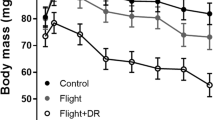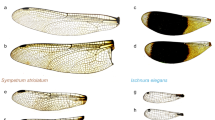Summary
As a comparison to the many studies of larger flying insects, we carried out an initial study of heat balance and thermal dependence of flight of a small butterfly (Colias) in a wind tunnel and in the wild.
Unlike many larger, or facultatively endothermic insects, Colias do not regulate heat loss by altering hemolymph circulation between thorax and abdomen as a function of body temperature. During flight, thermal excess of the abdomen above ambient temperature is weakly but consistently coupled to that of the thorax. Total heat loss is best expressed as the sum of heat loss from the head and thorex combined plus heat loss from the abdomen because the whole body is not isothermal. Convective cooling is a simple linear function of the square root of air speed from 0.2 to 2.0 m/s in the wind tunnel. Solar heat flux is the main source of heat gain in flight, just as it is the exclusive source for warmup at rest. The balance of heat gain from sunlight versus heat loss from convection and radiation does not appear to change by more than a few percent between the wings-closed basking posture and the variable opening of wings in flight, although several aspects require further study. Heat generation by action of the flight muscles is small (on the order of 100 m W/g tissue) compared to values reported for other strongly flying insects.
Colias appears to have only very limited capacity to modulate flight performance. Wing beat frequency varies from 12–19 Hz depending on body mass, air speed, and thoracic temperature. At suboptimal flight temperatures, wing beat frequency increases significantly with thoracic temperature and body mass but is independent of air speed. Within the reported thermal optimum of 35–39°C, wing beat frequency is negatively dependent on air speed at values above 1.5 m/s, but independent of mass and body temperature. Flight preference of butterflies in the wind tunnel is for air speeds of 0.5–1.5 m/s, and no flight occurs at or above 2.5 m/s. Voluntary flight initiation in the wild occurs only at air speeds ≦1.4 m/s.
In the field, Colias fly just above the vegetation at body temperatures of 1–2°C greater than when basking at the top of the vegetation. These measurements are consistent with our findings on low heat gain from muscular activity during flight. Basking temperatures of butterflies sheltered from the wind within the vegetation were 1–2°C greater than flight temperatures at vegetation height.
Similar content being viewed by others
References
Bartholomew GA (1981) A matter of size: an examination of endothermy in insects and terrestrial vertebrates. In: Insect thermoregulation. Heinrich B (ed) J Wiley & Sons, NY, pp 45–78
Campbell GS (1977) An Introduction to Environmental Biophysics. Springer, NY
Casey TM (1980) Flight energetics and heat exchange of gypsy moths in relation to air temperature. J Exp Biol 88:133–145
Casey TM (1981a) Behavioral mechanisms of thermoregulation. In: Insect thermoregulation. Heinrich B (ed) J Wiley & Sons, NY, pp 79–114
Casey TM (1981b) Insect flight energetics. In: Locomotion and Energetics in Arthropods. Herreid CF, Fourtner CR (eds) Plenum Press, NY, pp 419–452
Casey TM (1981c) Energetics and thermoregulation of Malacosoma americanum (Lepidoptera: Lasiocampidae) during hover flight. Physiol Zool 54:362–371
Casey TM, Joos BA (1983) Morphometrics, conductance, thoracic temperature, and flight energetics of noctuid and geometrid moths. Physiol Zool 56:160–173
Chappell MA (1982) Temperature regulation of carpenter bees (Xylocopa californica) foraging in the Colorado Desert of southern California. Physiol Zool 55:267–280
Chappell MA (1984a) Temperature regulation and energetics of the solitary bee Centris pallida during foraging and intermale mate competition. Physiol Zool 57:215–225
Chappell MA (1984b) Thermoregulation and energetics of the green fig beetle (Cotinus texana) during flight and foraging behavior. Physiol Zool 57:581–589
Douglas MM (1977) The behavioral and biophysical strategies of thermoregulation in temperate butterflies. PhD Thesis, University of Kansas, Lawrence
Ellington CP (1978) The aerodynamics of normal hovering flight: three approaches. In: Comparative physiology: water, ions, and fluid mechanics. Schmidt-Nielsen K, Bolis L, Maddrell SHP (eds) Cambridge Univ Press, NY, pp 327–345
Esch H (1976) Body temperature and flight performance of honeybees in a servomechanically controlled wind tunnel. J Comp Physiol A 109:265–277
Fraenkel GS, Gunn DL (1961) The orientation of animals. Dover, NY
Gates DM (1980) Biophysical Ecology: Springer, NY
Gates DM, Schmer RB (eds) (1975) Perspectives of Biophysical Ecology. Springer, NY
Greenewalt CH (1962) Dimensional relationships for flying animals. Smithsonian Misc Collections 144:1–46
Hegel JR, Casey TM (1982) Thermoregulation and control of head temperature in the sphinx moth, Manduca sexta. J Exp Biol 101:1–15
Heinrich B (1971) Temperature regulation of the sphinx moth, Manduca sexta. I. Flight energetics and body temperature during free and tethered flight. J Exp Biol 54:141–152
Heinrich B (1974) Thermoregulation in endothermic insects. Science 185:747–756
Heinrich B (1976) Heat exchange in relation to blood flow between thorax and abdomen in bumblebees. J Exp Biol 64:561–585
Heinrich B (1977) Why have some animals evolved to regulate a high body temperature? Amer Nat 111:623–640
Heinrich B (1979) Keeping a cool head: honeybee thermoregulation. Science 205:1269–1271
Heinrich B (1981) Ecological and evolutionary perspectives. In: Insect thermoregulation. Heinrich B (ed) J Wiley & Sons, NY, pp 235–302
Heinrich B, Casey TM (1978) Heat transfer in dragonflies: “fliers” and “perchers”. J Exp Biol 82:195–206
Josephson RK (1981) Temperature and mechanical performance of insect muscle. In: Insect thermoregulation. Heinrich B (ed) J Wiley & Sons, NY, pp 19–44
Kammer AE (1970) Thoracic temperature, shivering and flight in the monarch butterfly, Danaus plexippus (L.). Z Vergl Physiol 68:334–344
Kammer AE (1981) Physiological mechanisms of thermoregulation. In: Insect thermoregulation. Heinrich B (ed). J Wiley & Sons, NY, pp 115–158
Kammer AE, Heinrich B (1978) Insect flight metabolism. Adv Insect Physiol 13:133–228
Kingsolver JG (1983a) Thermoregulation and flight in Colias butterflies: elevational patterns and mechanistic limitations. Ecology 64:534–545
Kingsolver JG (1983b) Ecological significance of flight activity in Colias butterflies: implications for reproductive strategy and population structure. Ecology 64:546–551
Kingsolver JG, Moffat RJ (1982) Thermoregulation and the determinants of heat transfer in Colias butterflies. Oecologia (Berlin) 53:27–33
Kingsolver JG, Watt WB (1983) Thermoregulatory strategies in Colias butterflies: thermal stress and the limits to adaptation in temporally varying environments. Amer Nat 121:32–55
Kingsolver JG, Watt WB (1984) Mechanistic constraints and optimality models: thermoregulatory strategies in Colias butterflies. Ecology 65:1835–1839
Li JCR (1964) Statistical Inference, v II. Edwards, Ann Arbor
May M (1976) Thermoregulation and adaptation to temperature in dragonflies. Ecol Mon 46:1–32
Monteith JL (1973) Principles of environmental physics. Arnold, London
Morgan KR, Bartholomew GA (1982) Homeothermic response to reduced ambient temperature in a scarab beetle. Science 216:1409–1410
Nicholson SW, Louw GN (1982) Simultaneous measurement of evaporative water loss, oxygen consumption, and thoracic temperature during flight in a carpenter bee. J Exp Zool 222:287–296
Porter WP, Mitchell JW, Beckman WA, DeWitt CB (1973) Behavioral implications of mechanistic ecology. Oecologia (Berlin) 13:1–54
Rohlf FJ, Sokal RR (1981) Statistical Tables. WH Freeman and Co, San Francisco
Sokal RR, Rohlf FJ (1981) Biometry. WH Freeman and Co, San Francisco
Wasserthal LT (1975) The role of butterfly wings in regulation of body temperature. J Ins Physiol 21:1921–1930
Watt WB (1967) Pteridine biosynthesis in the butterfly Colias eurytheme. J Biol Chem 242:565–572
Watt WB (1968) Adaptive significance of pigment polymorphisms in Colias butterflies. I. Variation of melanin pigment in relation to thermoregulation. Evolution 22:437–458
Watt WB (1977) Adaptation at specific loci. I. Natural selection on phosphoglucose isomerase of Colias butterflies: biochemical and population aspects. Genetics 87:177–194
Watt WB (1983) Adaptation at specific loci. II. Demographic and biochemical elements in the maintenance of the Colias PGI polymorphism. Genetics 103:691–724
Watt WB (1985) Bioenergetics and evolutionary genetics-opportunities for new synthesis. Amer Nat 125:118–143
Watt WB, Chew FS, Snyder LRG, Watt AG, Rothschild DE (1977) Population structure of pierid butterflies. I. Numbers and movements of some montane Colias species. Oecologia (Berlin) 27:1–22
Watt WB, Han D, Tabashnik BE (1979) Population structure of pierid butterflies. II. A “native” population of Colias philodice eriphyle in Colorado. Oecologia (Berlin) 44:44–52
Watt WB, Cassin RC, Swan MS (1983) Adaptation at specific loci. III. Field behavior and survivorship differences among Colias PGI genotypes are predictable from in vitro biochemistry. Genetics 103:725–739
Watt WB, Carter PA, Blower SM (1985) Adaptation at specific loc. IV. Differential mating success along glycolytic allozyme genotypes of Colias butterflies. Genetics 109:157–175
Weis-Fogh TF (1956) Biology and physics of locust flight. II. Flight performance of the desert locus (Schistocerca gregaria). Phil Trans Roy Soc Lond B 329:459–510
Wilson DM (1968) The nervous control of insect flight and related behaviour. Adv Insect Physiol 5:289–338
Wright S (1951) The genetical structure of populations. Ann Eugen 15:323–354
Author information
Authors and Affiliations
Rights and permissions
About this article
Cite this article
Tsuji, J.S., Kingsolver, J.G. & Watt, W.B. Thermal physiological ecology of Colias butterflies in flight. Oecologia 69, 161–170 (1986). https://doi.org/10.1007/BF00377616
Received:
Issue Date:
DOI: https://doi.org/10.1007/BF00377616




